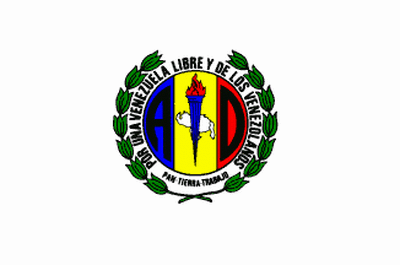
image by Guillermo Aveledo, 29 June 2004

Last modified: 2015-08-13 by zoltán horváth
Keywords: venezuela |
Links: FOTW homepage |
search |
disclaimer and copyright |
write us |
mirrors
See also:
No party is allowed to use, among its symbols, theVenezuelan
Flag or its colours (in any arranged order), the name of Simon
Bolivar and the Coat of arms. At party rallies, candidate podiums
and so on, it is alowed to use all of these (but it carries
certain controversy). Parties rarely wave flags, beyond some rags
with their colours (very rarelywith their logos on it), although
I have seen a Communist Party Flag at somerallies. A flag with
eight stars (as Bolivar's model in 1817 and 1819) has been flown
at the current party in power (Fifth Republic Movement)
rallies.But they are alligned in various positions, and move
around the flag from one rally to another
Guillermo Aveledo, 24 September 1999
As part of the murky restlessness my country is getting used
to , yet another Military officer is making political remarks:
this time, Colonel (Air Force) Silvino Bustillos remarked in a
press conference at the National Lectoral Council's free press
room thet President (retired Lt. Colonel) Hugo Chavez, was, among
some other nfr things, breaking the National Symbols Law, whichs
bans the usage of the anthem, flag and Coat of Arms by political
parties or factiones, or any politically interested group.
An hard-to-enforce law as it may be, this was already noted by me
last year on this very list. President Chavez, both as a
candidate and as a president-candidate (a first in Venezuela,
when reelection was just instituted by the 1999 Constitution) has
repeatedly used both the national flag (state and civil) and the
anthem on political meetings and rallies.
Quite conscientously or not, the use of national symbols is
forbidden in such activities (and no other candidate ever has
used these colours).
Guillermo Aveledo, 17 July 2000
It isn't possible make a complete count of the Venezuelan politicas flags without happening through history. Specially considering the recent changes in the Venezuelan politics. For that reason, I've elaborated three historical periods, following the reigns bibliography about Venezuelan political parties:
1) Political Flags during the formation of the National State (1830-1930s): Although images are few, almost null, the bibliographical information and the tracks me be useful. One treats, fundamentally, about flags of military commaders, leaders and pseudo-parties ("the historic" oligarchy parties), etc. On this stage the politics is nongiven for free partisan competition, with periods in which the politic fight was essentially belic, or was completely suppressed.
2) Political flags in the "National-Popular" stage (1930s-1989): the sprouting of the modern politic parties, with specifical organizations and ideologies, not always acompannied democraticas politic rules. But it forms the predominant system of parties during more of half century.
3) Contemporary Political flags (1989-2003): is the flags of new movements and politic organizations arisen by institutional changes of the last years of 1980s and the crises of the preceding system. Its sprouting was vertiginously accelerated since 1999, without it consolidates in a new clearly identifiable system.
Likewise, it can made another group of categories
simultaneously ideologic and historic. Following the point of
view of Professor Ramos Jimenez, we used his tipology about the
origin of Latin American politic parties:
a.. Oligarchy Parties (conervadores and liberal)
b.. Socialist Parties (Socialist -democratic, Communists,
Revolutionaries, Integrists)
c.. National-Popular Parties (Nationalistic and Populists)
d.. Democratic Parties (Socialdemocratas, Christian Democrat,
Neo-conservators, Neo-liberals)
The politic flag par excellence corresponds which we know of
modern politic parties. Groups different of politic parties,
nevertheless, it would be treaties like these ones. That is to
say, grouped in a meta-category of politic flags. I suggest, in
addition to sub-category "Politic Parties" the
following additional sub-categories:
a) Irregular groups (insurgency or counterinsurgency politic
movements, at the margin of the law, using or not violent
methods);
b) Not-partisan Politic Organizations (organizations which don't
have party discipline nor aspirations to reach power positions
and which, nevertheless, propose subjects and objectives of the
public politic agenda; usually they are very specifics in the
subjects or sectors which it represents. Will be, in great part
of cases, the Non Government Organizations, Unions, Employer's
Associations, etc);
c) Politicized Flags (flags of groups whose function and nature
aren't politic, but that due to the particularitities of each
country may appear promoting itself or acting politically). As
these flags belong from their nature to others categories, it
will be mantain the original classification for it (would be
originally religious, sport, etc.).
Guillermo Aveledo (translated by Raul Orta), 28
August 2003
"Law of National Flag, Coat and Anthem" in force
since 1954 - Article 16 says: "Everyone that somehow offends
or despises the Flag, the Coat and the Anthem of the Republic
will be punished in accordance with the Law. Under no
circumstance will be allowed to parties or politic organizations
the use of the Symbols of the Homeland in public concentrations
and proselytist propaganda".
Raul Orta, 10 June 2004

image by Guillermo Aveledo, 29 June 2004
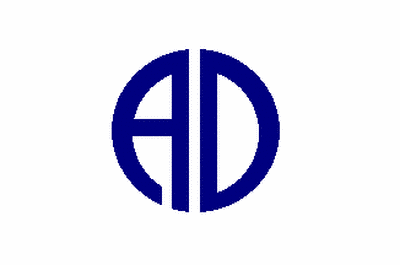
image by Guillermo Aveledo, 29 June 2004
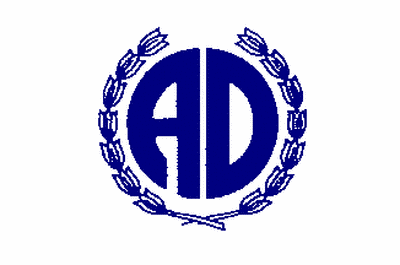
image by Guillermo Aveledo, 29 June 2004
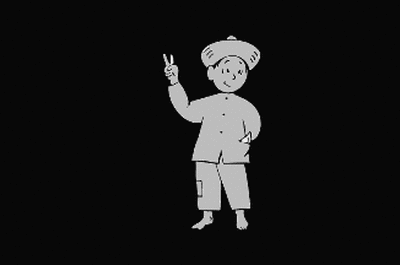
AD-government
image by Guillermo Aveledo, 29 June 2004
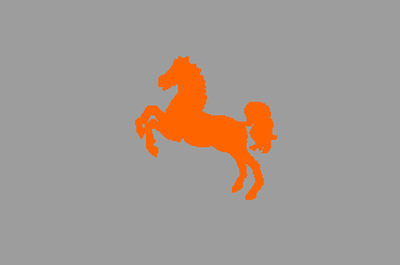
AD-opposition
image by Guillermo Aveledo, 29 June 2004
Acción Democrática [Democratic Action], who has
traditionally used bore the colour white, is one of
Venezuela’s main parties. Founded in 1941, it emerged from
the division of the Partido Democrático Nacional [National
Democratic Party], a coalition of left-wing intelelctuals and
politicians in the latter half of the 1930s. It has been the most
succesful of modern parties, gaining the presidency seven times
(once through a coup, in 1945). Its ideology is a creative blend
of nationalism and social democracy; currently, AD holds a number
of state governorships and is the second parliamentary force. AD
is a full standing member of the Socialist International.
Its logo is a tricolor (blue-yellow-red) roundel, divided
vertically. It mimicks the national colours, although the law
forbids the use of the national tricolour as a party simbol. On
its blue section, a roundened black "A" stands alone,
as a solitary black "D" does on its red section. A
torch and a stylised map of Venezuela stand on its central,
yellow section. Circling the roundel, two green lauril branches
and the partie’s mottoes in capital black letters: "POR
UNA VENEZUELA LIBRE Y DE LOS VENEZOLANOS" [For a free
Venezuela and for Venezuelans] and "PAN-TIERRA-TRABAJO"
[Bread-Ground-Work].
Normally, the party uses varians of its logo-on white flag. In
1963, during one of its many crisis, two factions of the party
claimed a right tu use the party colours in the upcoming national
election. The Supreme Court forbade any of the facitons to use
the party’s white and arms, deciding to award them to the
faction with most votes in the election. The AD-government
faction used black, with a cartoon figure of Juan Bimba (a
traditional carachter representing the average Venezuelan, now
definitely outdated; this cartoon was the famous depiction of
Juan Bimba made by cartoonist Mariano Medina Febres, MEDO, in the
1930s). The AD-opposition faction used silver grey, with the
orange silouette of a horse, rearing up. The AD-government
faction prevailed, and the party has not had its colour contested
ever again.
Guillermo Aveledo [remarks by Raúl Jesús Orta
Pardo], 29 June 2004
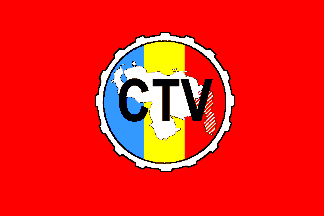
image by Guillermo Aveledo, 16 September 2000
The CTV is the most important labour organisation in
Venezuela. Although recently under fire, it serves as an umbrella
organisation for most of Venezuela's trade unions, much like
Britain's TUC. It has been dominated by the labour organisations
of the, again until recently, most important parties in Venezuela
(AD and Copei, with a lesser participation of the MAS and LCR;
the CTV emblem shows an uncanny familiarity to that of AD). There
are some rival trade unions associations, but this has been the
most important (founded in 1936) and the largest. It is now
challenged, although I'm not sure if aiming towards replacing the
upper cadres or removing the whole structure, by the newly formed
'Bolivarian Force of Workers'. This new movement has not shown a
flag yet.
The flag itself is a red field (typical of labour movements) over
which we see the CTV logo: a white gear (outlined in black),
which has sixteen teeth, with an inner circle divided in a
blue-yellow-red tricolor (unlike the national flag, but like the
tricolor shown in AD's logo), a white map of Venezuela (with the
white-red map of the claimed zone of Guyana by Venezuela, shown
in the logo since the 1960s), and, above it all, black, bold and
capital letters "CTV". Over the years, then logo has
suffered slight modifications, none of which are too critical so
as to be mentioned.
Guillermo Aveledo, 16 September 2000
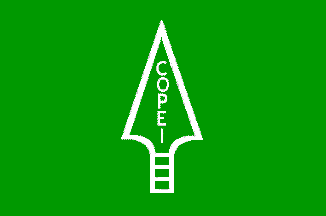
image by Guillermo Aveledo, 8 July 2004
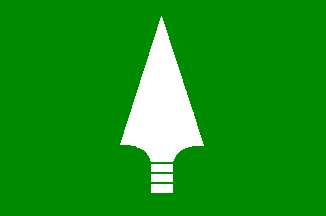
image by Guillermo Aveledo, 8 July 2004
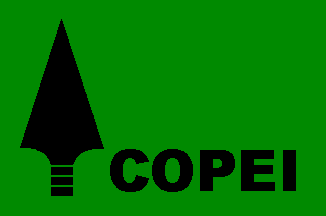
by Guillermo Aveledo, 8 July 2004
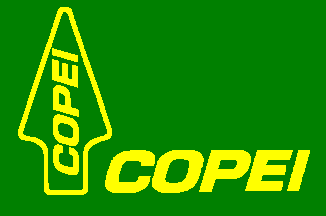
Currently in use
image by Guillermo Aveledo, 8 July 2004
.gif)
New logo
image by Guillermo Aveledo, 8 July 2004
Copei, the Venezuelan Christian Democratic party, was founded
in 1946. Its original strength came from conservative parties in
the Andes region and from young catholic students and
organisations in the centre of the country. By the 1960s, it had
established itself as a national party, and from 1968 until 1993,
as the main contender against AD. Copei (which stands for the
non-ideological name of Comité de Organizacion Politico
Electoral Independiente - Independent Electoral Politic
Organization Commitee) won the presidency in 1968 and in 1978;
currently, its national presence has diminished, as a result of
the disastrous elections of 2000; however, it remains as one of
the main opposition parties.
The traditional colour of Copei is green, in a myriad of shades
and tones. It used to fashion a darker, bottle-like, green, until
the eighties, when the tone became lighter. In 1988 and 1993, an
almost fluorescent green was used, but this was ultimately
dropped. In any case, no other party uses green as its colour.
The party's logo, a spearhead (sometimes referred to as an
arrowhead), has been depicted in several different ways. The
classical way has the party's initials within the spearhead. A
blunter spearhead is currently in use. These days the party also
shows a flag where this new spearhead stands within a green
globe, encircled by the caption: UNIDAD POR VENEZUELA (Unity for
Venezuela).
Guillermo Aveledo, 8 July 2004
The flag of Frente
Nacional Campesino Ezequiel Zamora - Ezequiel Zamora National
Peasant Front (FNCEZ) at <www.prensadefrente.org>.
Kevin Harrington, 1 November 2006
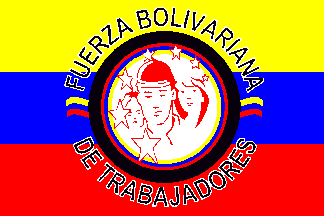
image by Guillermo Aveledo, 30 November 2000
Here's the flag of the FUERZA BOLIVARIANA DE TRABAJADORES
(Bolivarian Worker's Force), a government-supported labour union,
which was instituted in order to substitute CTV (our
longest-living and largest trade union) after today's referendum
on labour freedoms. The flag is a regular Venezuelan tricolori,
with the FBT's logo centered inside it. The logo consists of four
concentric rings, from outside to the inside: black, red, blue
and yellow. Within the rings, we have a white circle with three
antropomorphic faces (namely, what seems to be a working man with
a hard hat stands in front), drawn in red line art. Seven white
five-pointed red-embroidered stars, incremental in their size,
encircle almost half of the white circle, entering the red, blue
and yellow rings. On the sides of the ring, we have two small
trocolor tribands of yello-blue-red and, encircling it all, the
letters "FUERZA BOLIVARIANA DE TRABAJADORES" in black,
embroidered in white. This flag has been used as a paper waver
flag for supporters of the FBT, and as a huge stage flag (made
out of what seemed to be some sort of plastic or artificial
cloth) was used during a national convention of the FTB a few
months ago.
Guillermo Aveledo, 30 November 2000
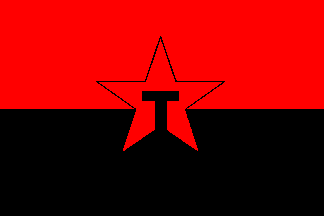
image by Guillermo Aveledo, 10 March 2005
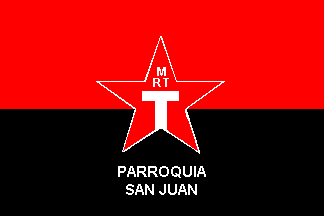
image by Guillermo Aveledo, 10 March 2005
There is a political organization in Venezuela which also
responds to the name of Tupamaros, evidently inspired by the Uruguayan movement, and as them, in the
history of Peruvian Tupac-Amaru. As they have stated tima and
again, the Movimiento Revolucionario Tupamaro is not a
"Venezuelan" movement,; it would be part of a global
struggle againstimperial domination.
The Movimiento Revolucionario Tupamaro is an urban left-wing
political movement founded in Western Caracas, having its
headquarters in the "23 de Enero" parish. It has an
imprecise origin, mostly related to the double struggle against
barrio violence and corruption and against the system in general,
and as dissidents of the major and institutionalized left-wing
parties (PCV, MAS, etc.) through the 1980s and 1990s.
After the end of most Cuban-inspired guerrilla warfare in
Venezuela, and the peaceful inclusion of the left into the
political system, far left groups, such as the Movimiento
Revolucionario Tupamaro, pursued a radical road, not
participating in electoral politicas and avoiding links with
mainstream organizations.
The flag of the Venezuelan Tupamaros (of which I send two spotted
versions), is horizontally divided in two parallel strips of
equal width and length, the upper strip being red and the lower
black. On its center, a black-embroidered five-pointed red star
sits. The variation has a white-embroidered star, with the name
of the "San Juan" parish. Although the red-black
combination is common for Anarchist groups, there's a certain
ambivalence in the Tupamaro's statements on the matter: they are
different from old-left parties, but they do not use the word
"Anarchy" (or its known symbols) in a positive light.
Mostly, the consider themselves not anarchic, and there should be
a difference between anarchic and Anarchist.
A description can be found in an interview made to one of the
Tupamaro's spokespersons, Jose Pinto at <lists.econ.utah.edu>.
Guillermo Aveledo, 10 March 2005
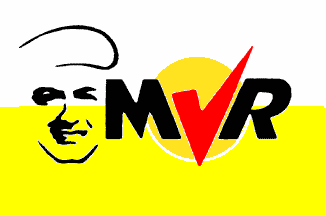
image by Guillermo Aveledo, 30 August 2004
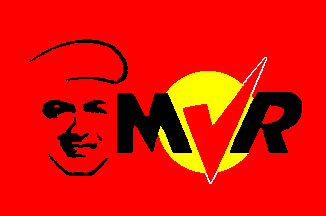
image by Guillermo Aveledo, 30 August 2004
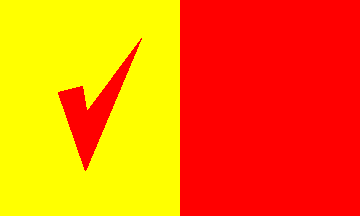
image by Guillermo Aveledo, 30 August 2004
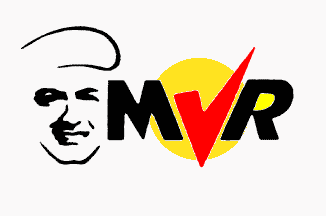
by Guillermo Aveledo, 30 August 2004
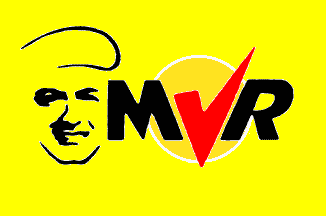
image by Guillermo Aveledo, 30 August 2004
The flags of the Fifth Republic Movement (MVR), the party of
Lt. Col. (ret.) Hugo Chavez. Founded in 1997, as a coalition of
non-partisan politicians from all extremes of the political
spectrum, it promoted Chavez to the Presidency in the 1998
elections. Its acronym, MVR, stands for Movimiento Quinta
República, or Fifth Republic Movement. In their theoretical
construction, the party follows a line commonly found throughout
Venezuela's traditional historical literature. There have been,
their analysis goes, four republics in Venezuela up to 1998. The
first republic (1810-1812) from the Declaration of Independence
to the fall of Puerto Cabello. The second republic (1813-1814)
from Bolivar's "Admirable Campaign" to the social
rebellion against the Republic; the third Republic (1821-1830),
from the Cucuta Convention to the break-up of the Republic of
Colombia. Then there was the Fourth Republic (1830-1998), which
began with the "repudiation" of Simon Bolivar and
lasted until the end of the forty years of democratic regime, in
1998. Chavez and his followers set out not only to modify the
constitution, like many times before, but to start off a clean
slate and start a new Republic. The new -Fifth- Republic began
with the approbation through a popular referendum of the 1999
Constitution. It has been noted that the capital
"V" in their acronym, which stands for the Roman
numeral 5, is a way to smoothly substitute the "B"
appearing in the military movement which organised the failed
coup attempts of 1992, and led the former paratrooper commander
Hugo Chavez to national fame: the MBR-200, Movimiento Bolivariano
Revolucionario-200. It is forbidden by law to use the national
symbols, including Bolivar's name, in favour of a particular
political party. At first, the MVR wanted to have a
radical appearance, but it could not choose red as its electoral
colour. It decided to choose a parted per fess flag in yellow and
white. Red is now its main colour, and Chavismo's followers sport
a red beret, akin to the paratroopers' battalion Chavez led.
Although some flags were produced with those colours, most
of them have been using an LOB format, over the colors red, white
and yellow. The party's logo has the letters MVR, with the
capital "V" mimicking an approval sign, and, to its
left, an effigy of Commander Chavez. Another flag, which could be
seen during the 2000 campaign, was the third flag: the cloth,
parted per fess in two, with the hoist half id yellow, bearing
the party's "V", and the fly half in red.
Guillermo Aveledo, 30 August 2004